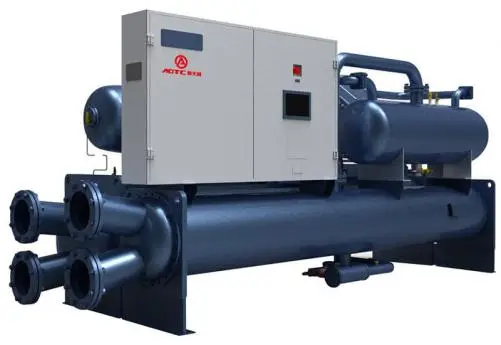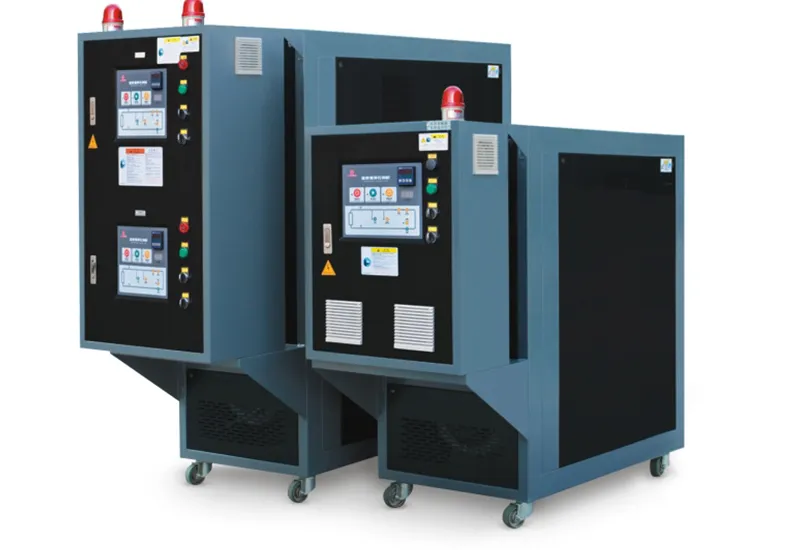AODE is a top industrial chiller manufacturer from china, specializes in high-performance industrial chillers, categorized into air cooled chiller and water cooled chiller, both essential for precise temperature control and efficient heat dissipation. Each type has its own advantages and disadvantages in practical applications, with significant differences between them. Our industrial chillers are widely used in injection molding, die casting, printing, rubber pressing, extruder cooling, chemical processing, and pharmaceuticals, ensuring stable operation, improved production efficiency, and extended equipment lifespan across diverse industrial applications. Below, we provide a detailed comparison of air-cooled chiller vs water cooled chiller.
Air cooled chiller is a refrigeration system that uses ambient air to dissipate heat through axial fans and finned condensers, eliminating the need for a water cooling system. They provide precise temperature control to maintain stable production conditions in industries such as plastics, printing, and chemical processing.
AODE air-cooled chillers feature dual hermetic scroll or piston compressors for efficient operation, with a temperature range of 7-35°C and cooling capacities up to 240KW+. Equipped with PLC or microcomputer controls, high-efficiency heat exchangers, and energy-saving designs, they ensure reliable, low-maintenance cooling, ideal for water-scarce environments.
Air Cooled Chiller Widely used in:
Injection molding – Ensures consistent cooling for mold temperature control.
Die casting – Enhances cooling efficiency for metal molds.
Printing & Rubber Pressing – Prevents overheating in continuous production.
Chemical Processing – Maintains stable temperatures for sensitive reactions.
Plug-and-play installation – No need for a cooling tower, reducing setup costs.
Dual hermetic scroll or piston compressors – Ensures high-efficiency cooling, with AODE models offering up to 87.2KW cooling capacity.
Low maintenance – Eliminates water-related scaling, corrosion, and leakage issues.
Advanced microcomputer or PLC control – Supports RS485 communication for automated monitoring.
Wide temperature control range – 7-35°C, suitable for industrial applications.
Highly efficient evaporator and condenser – Reduces energy consumption by 30%.
Power supply – 3N-380V 50HZ, meeting industrial power requirements.
Robust structure – Built with high-density insulation, thick copper tubing (1.0-1.2mm), and premium electric components (OMRON, FUJI, TE, LG, MOELLER, SCHNEIDER).
Compact and portable design – Size: 2080×1000×2055mm, Weight: 880kg, making it suitable for flexible industrial deployment.
With AODE's air-cooled chiller technology, businesses benefit from efficient, cost-effective, and reliable temperature control solutions tailored for heavy-duty industrial applications.

Water cooled chiller is a refrigeration system that utilizes a continuous water circulation system, transferring heat through a condenser and dissipating it via an external cooling tower. These chillers provide superior cooling efficiency and temperature stability, making them ideal for industries with high cooling demands and access to a stable water supply. They are widely used in metal processing, pharmaceuticals, food production, chemical manufacturing, power plants, and precision machining, ensuring consistent performance and product quality.
AODE water-cooled chillers feature hermetic scroll or screw compressors, offering cooling capacities exceeding 240KW+. With a temperature control range of 5-30°C, they provide high efficiency and low energy consumption. The integration of PLC or microcomputer control ensures precise operation, while high-quality stainless steel plate or shell-and-tube heat exchangers enhance thermal transfer. These chillers operate with lower noise levels than air-cooled models and have a more compact design, as cooling towers are installed separately.
AODE water-cooled chillers are widely used in metal processing, pharmaceuticals, food production, chemical manufacturing, large-scale industrial cooling, power plants, and precision machining. They provide consistent cooling to maintain optimal operating temperatures, ensuring product quality, process stability, and extended equipment lifespan.
Higher efficiency in environments with a stable water supply, reducing energy consumption and operational costs.
More compact chiller unit design, as cooling towers are installed separately, saving indoor space while enhancing cooling performance.
Lower noise levels compared to air-cooled models, making them suitable for noise-sensitive industrial environments.
Superior temperature stability with a control range of 5-30°C, ideal for processes requiring precise thermal management.
Cooling capacity ranging from 30KW to 240KW+, with high-performance hermetic scroll or screw compressors for reliable and efficient operation.
Requires an additional cooling tower and piping system for heat dissipation, ensuring effective thermal exchange for large-scale applications.

| Category | Air Cooled Chiller | Water Cooled Chiller |
|---|---|---|
| Definition | Uses ambient air for heat dissipation via axial fans and finned condensers. | Utilizes circulating water from a cooling tower for heat dissipation. |
| Cooling Capacity | Up to 240KW+ (depending on model). | From 30KW to 240KW+ (depending on model). |
| Temperature Control Range | 7°C to 35°C. | 5°C to 30°C. |
| Efficiency | Moderate efficiency, suitable for water-scarce environments. | Higher efficiency, especially in stable water supply environments. |
| Cooling Mechanism | Air is used to dissipate heat through fans and condensers. | Water is used in a continuous circulation system to dissipate heat through a condenser. |
| Power Supply | 3N-380V 50HZ, industrial standard. | 3N-380V 50HZ, industrial standard. |
| Compressor Type | Dual hermetic scroll or piston compressors. | Hermetic scroll or screw compressors. |
| Control System | PLC or microcomputer control, supports RS485 communication. | PLC or microcomputer control, precise operation. |
| Maintenance | Low maintenance, no water-related scaling or corrosion. | Requires regular maintenance for cooling tower and piping. |
| Noise Level | Higher noise levels due to fans. | Lower noise levels, suitable for noise-sensitive environments. |
| Space Requirement | Compact and portable, no need for a cooling tower. | More compact chiller unit but requires a separate cooling tower. |
| Energy Consumption | Energy-efficient with up to 30% savings in energy. | Lower energy consumption in stable environments with water. |
| Cost | Generally more affordable due to lower installation costs. | Higher upfront cost due to the need for additional cooling towers. |
| Cost-Effectiveness | Ideal for areas with water scarcity or limited space. | Long-term cost savings with high efficiency and lower operating costs. |
| Applications | Injection molding, die casting, printing, rubber pressing, chemical processing. | Metal processing, pharmaceuticals, food production, large-scale industrial cooling, power plants. |
| Cooling Environment | Outdoor or areas with limited access to water. | Stable environments with a continuous water supply. |
| Additional Components | No additional components needed beyond the chiller itself. | Requires an additional cooling tower and piping system. |
| Space Efficiency | Very space-efficient with a compact design. | Requires more space due to the need for a separate cooling tower. |
| Installation Complexity | Easier installation with "plug-and-play" setup. | More complex installation due to the need for a cooling tower and plumbing. |

Air Cooled Chiller
| Water Cooled Chiller:
|
Air Cooled Chiller:
| Water Cooled Chiller:
|
Air Cooled Chiller:
| Water Cooled Chiller:
|
Air Cooled Chiller:
| Water Cooled Chiller:
|
Air Cooled Chiller:
| Water Cooled Chiller:
|
Air Cooled Chiller Misconceptions:
| Water Cooled Chiller Misconceptions:
|
For smaller-scale operations, industries with space constraints, or those located in areas with water limitations, the AODE Air Cooled Chiller is the most appropriate choice.
For larger industries with continuous high-load cooling needs, stable water supply, and long-term efficiency goals, the AODE Water Cooled Chiller provides the best performance and cost savings over time.